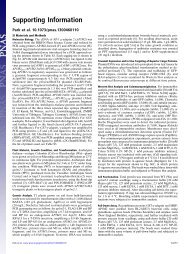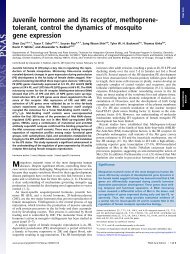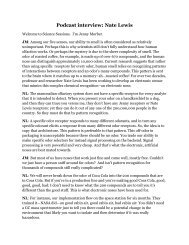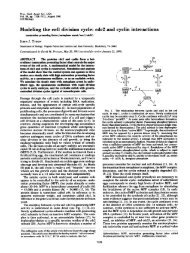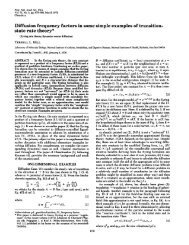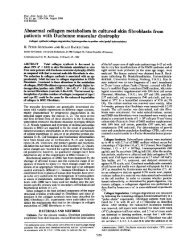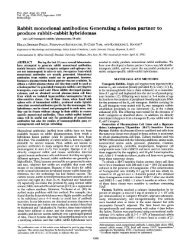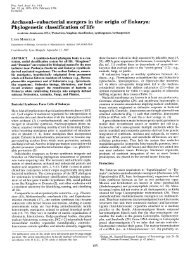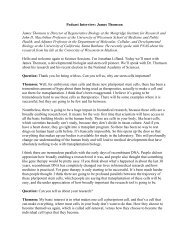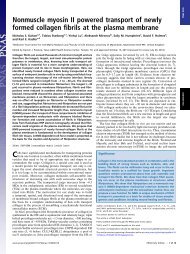EosFP, a fluorescent marker protein with UV-inducible green-to-red ...
EosFP, a fluorescent marker protein with UV-inducible green-to-red ...
EosFP, a fluorescent marker protein with UV-inducible green-to-red ...
You also want an ePaper? Increase the reach of your titles
YUMPU automatically turns print PDFs into web optimized ePapers that Google loves.
<strong>EosFP</strong>, a <strong>fluorescent</strong> <strong>marker</strong> <strong>protein</strong> <strong>with</strong> <strong>UV</strong>-<strong>inducible</strong><br />
<strong>green</strong>-<strong>to</strong>-<strong>red</strong> fluorescence conversion<br />
Jörg Wiedenmann* † , Sergey Ivanchenko †‡ , Franz Oswald †§ , Florian Schmitt*, Carlheinz Röcker ‡ , Anya Salih ,<br />
Klaus-Dieter Spindler*, and G. Ulrich Nienhaus ‡� **<br />
Departments of *General Zoology and Endocrinology, ‡ Biophysics, and § Internal Medicine I, University of Ulm, 89069 Ulm, Germany; Electron Microscope<br />
Unit, University of Sydney, NSW 2006, Australia; and � Department of Physics, University of Illinois at Urbana–Champaign, Urbana, IL 61801<br />
Edited by Peter G. Wolynes, University of California at San Diego, La Jolla, CA, and approved September 23, 2004 (received for review May 24, 2004)<br />
A gene encoding a <strong>fluorescent</strong> <strong>protein</strong> from the s<strong>to</strong>ny coral<br />
Lobophyllia hemprichii has been cloned in Escherichia coli and<br />
characterized by biochemical and biophysical methods. The <strong>protein</strong>,<br />
which we named <strong>EosFP</strong>, emits strong <strong>green</strong> fluorescence (516<br />
nm) that changes <strong>to</strong> <strong>red</strong> (581 nm) upon near-<strong>UV</strong> irradiation at �390<br />
nm because of a pho<strong>to</strong>-induced modification involving a break in<br />
the peptide backbone next <strong>to</strong> the chromophore. Single-molecule<br />
fluorescence spectroscopy shows that the wild type of <strong>EosFP</strong> is<br />
tetrameric, <strong>with</strong> strong Förster resonance coupling among the<br />
individual fluorophores. We succeeded in breaking up the tetramer<br />
in<strong>to</strong> AB and AC subunit dimers by introducing the single point<br />
mutations V123T and T158H, respectively, and the combination of<br />
both mutations yielded functional monomers. Fusion constructs<br />
<strong>with</strong> a variety of <strong>protein</strong>s were prepa<strong>red</strong> and expressed in human<br />
cells, showing that normal biological functions were retained. The<br />
possibility <strong>to</strong> locally change the emission wavelength by focused<br />
<strong>UV</strong> light makes <strong>EosFP</strong> a superb <strong>marker</strong> for experiments aimed at<br />
tracking the movements of biomolecules <strong>with</strong>in the living cell.<br />
In recent years, <strong>fluorescent</strong> <strong>protein</strong> (FP) technology has provided<br />
powerful new <strong>to</strong>ols for cell biology. FPs can be fused <strong>to</strong><br />
essentially all <strong>protein</strong>s of interest, enabling real-time moni<strong>to</strong>ring<br />
of biochemical processes in living cells, including <strong>protein</strong> expression,<br />
localization, and movement (1–3). Based on GFP,<br />
which is from the luminescent jellyfish Aequorea vic<strong>to</strong>ria, a<br />
variety of mutants <strong>with</strong> shifted emission wavelengths and enhanced<br />
fluorescence were developed that provide researchers<br />
<strong>with</strong> <strong>fluorescent</strong> <strong>marker</strong>s in many different hues. The FP <strong>to</strong>olbox<br />
has been greatly extended since the discovery of GFP homologs<br />
in nonbioluminescent anthozoa (4–11). Some of the anthozoan<br />
FPs exhibit properties that are not found in GFP derivatives,<br />
including fluorescence emission in the <strong>red</strong> spectral range.<br />
The tracking of objects <strong>with</strong>in live cells is an important<br />
application in cell biology (12) and can be accomplished by using<br />
FP <strong>marker</strong>s that can be activated locally by light. For example,<br />
irradiation of the GFP mutant T203H <strong>with</strong> intense blue light at<br />
413 nm causes an increase of the <strong>green</strong> emission (excited at 488<br />
nm) by 2 orders of magnitude (12). The <strong>red</strong> fluorescence of<br />
kindling FP 1, a mutant of asCP (A148G), can be increased by<br />
a fac<strong>to</strong>r of 30 by using <strong>green</strong> light at 532 nm (13). The FP Kaede,<br />
recently isolated from the scleractinian coral Trachyphyllia geoffroyi<br />
(14), appears particularly powerful for localized <strong>fluorescent</strong><br />
marking. Instead of enhancing the emission by pho<strong>to</strong>activation,<br />
Kaede can be irreversibly converted from a <strong>green</strong>- <strong>to</strong> a <strong>red</strong>emitting<br />
form by using near-<strong>UV</strong> light.<br />
Here we describe the cloning, characterization, and genetic<br />
engineering of an FP from the scleractinian coral Lobophyllia<br />
hemprichii that irreversibly switches its peak emission from 516<br />
<strong>to</strong> 581 nm upon <strong>UV</strong> irradiation. We have christened this <strong>protein</strong><br />
<strong>EosFP</strong> after the goddess of dawn in Greek mythology. By<br />
introducing mutations in the subunit interfaces, we have created<br />
dimeric and monomeric forms <strong>with</strong> essentially unchanged spectroscopic<br />
properties. We also present applications of <strong>EosFP</strong> as<br />
a fusion <strong>marker</strong> <strong>protein</strong>.<br />
Materials and Methods<br />
Cloning, Mutagenesis, Protein Expression, and Purification. A cDNA<br />
library of L. hemprichii was constructed and expressed in Escherichia<br />
coli (XLOLR) (8, 9). During the screening of bacterial<br />
colonies for <strong>fluorescent</strong> clones under the fluorescence microscope,<br />
several colonies changed color from <strong>green</strong> <strong>to</strong> orange<br />
under 365-nm irradiation. The coding cDNA fragment was then<br />
subcloned in<strong>to</strong> pQE32 (Qiagen, Hilden, Germany). Site-directed<br />
mutagenesis was performed by using the QuikChange Site-<br />
Directed Mutagenesis kit (Stratagene). The resulting clones<br />
were sequenced by a commercial provider (Microsynth, Balgach,<br />
Switzerland). All <strong>protein</strong>s were expressed in E. coli (M15<br />
pREP4) and purified as described in ref. 9.<br />
Spectroscopic Characterization and SDS�PAGE Analysis. Optical absorption<br />
and fluorescence properties were determined as reported<br />
in ref. 9. To examine whether pho<strong>to</strong>conversion was accompanied by<br />
backbone cleavage, as was shown for Kaede (15), we slowly<br />
converted diluted 3-ml samples in the fluorometer by using 400-nm<br />
irradiation. The sample in the quartz cuvette was gently stir<strong>red</strong> <strong>to</strong><br />
ensure homogeneous exposure <strong>to</strong> light, and the emission at 581 nm<br />
was measu<strong>red</strong> every 2 min. Five 20-�l aliquots were removed during<br />
irradiation and analyzed by SDS�PAGE <strong>with</strong> 15% polyacrylamide<br />
gels. After silver staining, the gel was imaged in a Bio-Rad<br />
MultiImager and analyzed <strong>with</strong> MULTIANALYST software. Alternatively,<br />
<strong>protein</strong>s were transfer<strong>red</strong> <strong>to</strong> a nitrocellulose membrane (NC<br />
45, Serva) after electrophoresis by the semidry blotting procedure<br />
described by Khyse-Andersen (16). The membrane was imaged<br />
<strong>with</strong> <strong>UV</strong> light (366 nm) and a digital camera (Kaiser Fo<strong>to</strong>technik,<br />
Buchen, Germany) equipped <strong>with</strong> a standard ethidium bromide<br />
filter.<br />
Single-Molecule Microscopy. We used 488-nm light from an Ar � �<br />
Kr � ion laser (modified model 164, Spectra-Physics) <strong>to</strong> excite the<br />
<strong>green</strong> and <strong>red</strong> forms of <strong>EosFP</strong>. We passed 800-nm light from an<br />
Ar � -laser-pumped Ti:sapphire laser (Innova Sabre�Mira 900, Coherent,<br />
Santa Clara, CA) through a frequency doubler (TP1B,<br />
Uniwave Technologies, Chatsworth, CA) <strong>to</strong> generate 400-nm light<br />
for <strong>green</strong>–<strong>red</strong> pho<strong>to</strong>conversion. The two light sources were combined<br />
<strong>with</strong> a cold mirror (M43–845, Edmund Optics, Barring<strong>to</strong>n,<br />
NJ) before entering a single-mode quartz fiber (QSMJ 320, OZ<br />
Optics, Carp, Canada) through which the light was fed in<strong>to</strong> a<br />
confocal microscope of our own design based on a Zeiss inverted<br />
Axiovert 35 microscope <strong>with</strong> two-channel fluorescence detection<br />
This paper was submitted directly (Track II) <strong>to</strong> the PNAS office.<br />
Abbreviations: FP, <strong>fluorescent</strong> <strong>protein</strong>; EGFP, enhanced GFP; d1<strong>EosFP</strong>, dimer 1 <strong>EosFP</strong>;<br />
d2<strong>EosFP</strong>, dimer 2 <strong>EosFP</strong>, m<strong>EosFP</strong>, monomeric <strong>EosFP</strong>; RBP, recombination signal-binding<br />
<strong>protein</strong>; mNotch, mouse Notch; MW, molecular mass.<br />
Data deposition: The sequence reported in this paper has been deposited in the GenBank<br />
database (accession no. AY765217).<br />
† J.W., S.I., and F.O. contributed equally <strong>to</strong> this work.<br />
**To whom correspondence should be addressed. E-mail: uli@uiuc.edu.<br />
© 2004 by The National Academy of Sciences of the USA<br />
www.pnas.org�cgi�doi�10.1073�pnas.0403668101 PNAS � November 9, 2004 � vol. 101 � no. 45 � 15905–15910<br />
BIOPHYSICS
Fig. 1. Concentration dependence of the apparent MW in size-exclusion<br />
chroma<strong>to</strong>graphy experiments on <strong>EosFP</strong> and mutants. Fitted binding isotherms,<br />
calculated by assuming saturation levels at 40 and 66 kDa, are shown<br />
as solid lines. Data for the monomeric EGFP and tetrameric DsRed are included<br />
for comparison (�). ■, wild type; }, d1<strong>EosFP</strong>; Œ, d2<strong>EosFP</strong>; F, m<strong>EosFP</strong>.<br />
and a piezoelectric sample scanning stage (9, 17). For <strong>EosFP</strong>, we<br />
used an excitation dichroic mirror Q495LP (AHF, Tübingen,<br />
Germany), <strong>green</strong>–<strong>red</strong> beam-splitting dichroic 560 DCXR (AHF),<br />
and two bandpass filters, HQ 535�70 and HQ 610�75 (AHF).<br />
For single-molecule microscopy, the <strong>EosFP</strong> molecules were<br />
biotinylated (biotin-XX, sulfosuccinimidyl ester, Molecular<br />
Probes) and attached by means of a streptavidin–biotin linkage<br />
<strong>to</strong> glass coverslips coated <strong>with</strong> biotinylated BSA (BSA–biotin,<br />
Sigma–Aldrich) by using standard procedures.<br />
For determining the pH dependence of the pho<strong>to</strong>conversion<br />
rate, dense layers of surface-bound <strong>EosFP</strong> were exposed <strong>to</strong><br />
400-nm light. The increase of the <strong>red</strong> fluorescence <strong>with</strong> time was<br />
measu<strong>red</strong> and analyzed <strong>to</strong> obtain the rates.<br />
Eukaryotic Expression and Imaging. Vec<strong>to</strong>r constructs, transfection,<br />
and eukaryotic expression are described in Supporting Materials<br />
and Methods: Vec<strong>to</strong>r Constructs and Eukaryotic Expression, which<br />
is published as supporting information on the PNAS web site.<br />
Cells were imaged by using our home-built microscope <strong>with</strong><br />
single-molecule sensitivity or a commercial setup (DM IRB,<br />
Leica) equipped <strong>with</strong> a digital camera (C4742, Hamamatsu,<br />
Ichinocho, Japan), a 100-W mercury lamp, a BP430�50 excitation<br />
filter, and a 425 DCLP beam splitter (AHF) for pho<strong>to</strong>conversion.<br />
Pho<strong>to</strong>conversion can also be induced by using a standard<br />
4�,6-diamidino-2-phenylindole (DAPI) filter set. Green and <strong>red</strong><br />
fluorescence was imaged by using FITC and tetramethylrhodamine<br />
B isothiocyanate (TRITC) filter sets.<br />
Results and Discussion<br />
Primary Structure. The FP from L. hemprichii consists of 226<br />
amino acids <strong>with</strong> a calculated molecular mass of 25.8 kDa and a<br />
pI of 6.9. The sequence of <strong>EosFP</strong> is closest <strong>to</strong> that of Kaede (84%<br />
identical residues) from T. geoffroyi (14). (A sequence alignment<br />
is published as Fig. 7, which is published as supporting information<br />
on the PNAS web site.) Light-induced <strong>green</strong>-<strong>to</strong>-<strong>red</strong><br />
pho<strong>to</strong>conversion appears <strong>to</strong> depend on the presence of a histidine<br />
in the first position of the tripeptide HYG from which the<br />
chromophore is formed. In <strong>EosFP</strong>, substitution of this residue<br />
<strong>with</strong> M, S, T, and L yielded brightly <strong>green</strong> FPs that were no<br />
longer convertible.<br />
Monomerization of <strong>EosFP</strong>. Upon expression in E. coli, the wild-type<br />
form of <strong>EosFP</strong> appears as a tetramer in size-exclusion chroma<strong>to</strong>graphy<br />
(Fig. 1), and its apparent molecular mass (MW), of �66 kDa,<br />
is identical <strong>to</strong> that of DsRed, which is known <strong>to</strong> be tetrameric (18,<br />
19). Homology modeling of the interfaces of DsRed; its monomerized<br />
version, mRFP1; and <strong>EosFP</strong> guided our mutation strategy. In<br />
DsRed, the interface between subunits A and B displays hydrophobic<br />
interactions among amino acids V127, I180, and V96. In the<br />
course of DsRed monomerization, the AB interface was made<br />
more hydrophilic by introducing the polar mutations V127T and<br />
I180T. <strong>EosFP</strong> has already polar threonine and serine amino acids<br />
at the positions corresponding <strong>to</strong> I180 and V96. To render this<br />
interface even more hydrophilic, we introduced the additional<br />
substitution V123T. A homologous mutation was also introduced<br />
recently in the monomerization of Azami <strong>green</strong> (20). Size-exclusion<br />
chroma<strong>to</strong>graphy revealed a MW of �40 kDa for this variant at 10<br />
�M concentration of monomer subunits, which is between the MW<br />
values for tetrameric DsRed and monomeric GFP (Fig. 1), suggesting<br />
that this mutant is indeed an AC dimer. We will refer <strong>to</strong> this<br />
mutant as dimer 1 <strong>EosFP</strong> (d1<strong>EosFP</strong>). The MW increase <strong>to</strong>ward<br />
higher concentrations is consistent <strong>with</strong> the presence of a dimer–<br />
tetramer equilibrium, <strong>with</strong> a Kd of 0.35 mM (Fig. 1).<br />
In DsRed, the AC interface contains a positively charged R149<br />
interacting <strong>with</strong> A164 and L174. To break up this interface, a<br />
second arginine was introduced by the substitution A164R (18). In<br />
<strong>EosFP</strong>, residues homologous <strong>to</strong> R149 and L174 are already positively<br />
charged (R170 and K145, respectively). This observation<br />
suggests that the interactions between the A and C subunits are<br />
weaker in <strong>EosFP</strong> than in DsRed. For another GFP-like <strong>protein</strong>,<br />
RTMS5 (21), F158 was replaced by histidine <strong>to</strong> break up the AC<br />
interface. We introduced the corresponding mutation in <strong>EosFP</strong><br />
(T158H) and obtained a variant <strong>with</strong> the same MW as d1<strong>EosFP</strong>;<br />
hence, it is also dimeric (at 10 �M) and will be denoted as dimer<br />
2 <strong>EosFP</strong> (d2<strong>EosFP</strong>). Again, an increase of MW <strong>to</strong>ward higher<br />
Fig. 2. Spectra of the <strong>green</strong> and <strong>red</strong> states of <strong>EosFP</strong> at pH 7 and pH 5.5. Solid<br />
lines, absorbance; dashed lines, excitation; dotted lines, emission spectra. (A<br />
and C) Green species at pH 7 (A) and pH 5.5 (C). Excitation (emission) spectra<br />
were measu<strong>red</strong> <strong>with</strong> emission (excitation) set <strong>to</strong> 520 (490) nm. E, conversion<br />
yields scaled <strong>to</strong> the absorbance. (Inset) In vitro chromophore maturation at<br />
27°C determined from the absorbance at 506 nm (solid line, exponential fit).<br />
(B and D) Red species at pH 7 (B) and pH 5.5 (D). Excitation (emission) spectra<br />
were measu<strong>red</strong> <strong>with</strong> emission (excitation) set <strong>to</strong> 590 (560) nm.<br />
15906 � www.pnas.org�cgi�doi�10.1073�pnas.0403668101 Wiedenmann et al.
Fig. 3. Normalized pH dependencies of absorbance, emission, and pho<strong>to</strong>conversion<br />
rate. All data follow a Henderson–Hasselbalch relation <strong>with</strong> pK of<br />
5.8 � 0.1 (solid lines). Green species: F, absorbance at 506 nm; ■, absorbance<br />
at 390 nm; E, fluorescence at 516 nm; �, relative <strong>green</strong>-<strong>to</strong>-<strong>red</strong> conversion rate.<br />
Red species: }, absorbance at 572 nm; {, fluorescence at 581 nm.<br />
concentrations indicates a shift of the equilibrium <strong>to</strong> a tetrameric<br />
form, <strong>with</strong> Kd � 1.0 mM. By combining the two mutations, V123T<br />
and T158H, both the AB and AC interfaces were broken up<br />
simultaneously, yielding a monomeric variant (m<strong>EosFP</strong>) <strong>with</strong> an<br />
MW of 25 kDa, which is essentially identical <strong>to</strong> that of monomeric<br />
enhanced GFP (EGFP) (Fig. 1). The increase of MW <strong>with</strong> concentration<br />
reflects a tendency <strong>to</strong> form dimers at higher concentrations.<br />
The observed Kd of 0.1 mM is comparable <strong>with</strong> that of GFP and its<br />
variants (22).<br />
Spectroscopic Characterization. Upon expression in E. coli, <strong>EosFP</strong><br />
matures <strong>to</strong> a <strong>green</strong>-emitting form <strong>with</strong> a time dependence that can<br />
be described by an exponential <strong>with</strong> a half-life of 1.3 h (Fig. 2A<br />
Inset). The absorption spectrum at pH 7 shows a prominent band<br />
at 506 nm, <strong>with</strong> a shoulder at 482 nm (Fig. 2A). The extinction<br />
coefficient of the monomeric subunit was determined as 72,000<br />
M �1 �cm �1 . With decreasing pH, a new band at 390 nm increases at<br />
the expense of the 506-nm absorption (Fig. 2C). The pH dependences<br />
of the absorbances at 506 and 390 nm can be well fitted by<br />
using a Henderson–Hasselbalch relation <strong>with</strong> pK � 5.8 � 0.1,<br />
suggesting that a single pro<strong>to</strong>nation governs the observed spectral<br />
changes (Fig. 3). The presence of a crisp isosbestic point at 432 nm<br />
also supports an interconversion between two species (data not<br />
shown). The band at 390 nm is missing in the excitation spectrum,<br />
as is clearly seen in the spectrum at pH 5.5 (Fig. 2C), implying that<br />
the pro<strong>to</strong>nated species does not fluoresce. For EGFP, similar<br />
spectral changes <strong>with</strong> pH have been observed, <strong>with</strong> an identical pK<br />
of 5.8 (23). They have been attributed <strong>to</strong> pro<strong>to</strong>nation of the hydroxyl<br />
group of the tyrosine residue in the chromophore. However, in<br />
contrast <strong>to</strong> <strong>EosFP</strong>, excitation of the pro<strong>to</strong>nated form leads <strong>to</strong><br />
fluorescence emission in GFP, involving an excited-state depro<strong>to</strong>nation<br />
of the fluorophore (24, 25). In Fig. 2, the absorption at 280<br />
nm is due <strong>to</strong> aromatic amino acids; they efficiently transfer their<br />
excitation energy <strong>to</strong> the <strong>green</strong> chromophore. The <strong>green</strong> fluorescence<br />
emission peaks at 516 nm, <strong>with</strong> a quantum yield of 0.7. The<br />
pH dependence of the emission tracks the dependence of the<br />
Table 1. Properties of <strong>EosFP</strong> and mutants<br />
absorption (Fig. 3). This behavior is expected if only the depro<strong>to</strong>nated<br />
species fluoresces <strong>with</strong> a quantum yield that is insensitive<br />
<strong>to</strong> pH.<br />
Irradiation <strong>with</strong> near-<strong>UV</strong> light at �390 nm causes conversion<br />
of the <strong>green</strong>- <strong>to</strong> the <strong>red</strong>-emitting form (Fig. 2 B and D). The<br />
maximum of the <strong>red</strong> absorption and excitation is located at 571<br />
nm, and a vibronic sideband is clearly visible at 533 nm. The<br />
extinction coefficient per monomer of the <strong>red</strong> species was<br />
determined as 41,000 M �1 �cm �1 . In addition <strong>to</strong> the 280-nm band<br />
in the near-<strong>UV</strong>, there is a set of absorption bands of �350 nm<br />
arising from excitations in<strong>to</strong> higher electronic states. The <strong>red</strong><br />
fluorescence peaks at 581 nm, and a vibronic is located at 629<br />
nm. The quantum yield of the <strong>red</strong>-emitting form is 0.55. The<br />
spectroscopic data are compiled in Table 1 for wild-type <strong>EosFP</strong><br />
and its variants. It is evident from these data that dimerization<br />
or monomerization does not have detrimental effects on the<br />
spectral properties of this <strong>protein</strong>.<br />
Green-<strong>to</strong>-Red Pho<strong>to</strong>conversion. The wavelength dependence of the<br />
<strong>green</strong>-<strong>to</strong>-<strong>red</strong> conversion yield was determined from the <strong>red</strong><br />
emission after irradiating <strong>green</strong> samples (pH 7) at several<br />
wavelengths for 3 min in the fluorometer. Fig. 2C shows that the<br />
yield closely tracks the 390-nm absorbance band of the <strong>green</strong><br />
species. Moreover, the pH dependence of the pho<strong>to</strong>conversion<br />
rate is proportional <strong>to</strong> the fraction of pro<strong>to</strong>nated <strong>EosFP</strong> species<br />
(Fig. 3). These observations suggest that the pro<strong>to</strong>nated form of<br />
the chromophore is crucial for pho<strong>to</strong>conversion; excited-state<br />
pro<strong>to</strong>n transfer is likely involved in the mechanism. Fig. 4 shows<br />
results from an experiment in which SDS�PAGE and spectroscopic<br />
analysis were combined. While irradiating an <strong>EosFP</strong><br />
sample in the fluorometer for 10 h <strong>with</strong> 400-nm light, we<br />
observed the disappearance of the <strong>green</strong> species <strong>with</strong> concomitant<br />
appearance of the <strong>red</strong> form (Fig. 4A). The increase in the<br />
<strong>red</strong> species was accompanied by the appearance of two peptide<br />
fragments on the gel, <strong>with</strong> apparent MW values of �20 and �8<br />
kDa (Fig. 4 A and B), whereas the band at �25 kDa representing<br />
the full-length peptide decreased. Apparently, <strong>green</strong>-<strong>to</strong>-<strong>red</strong> conversion<br />
involves dissociation of the peptide backbone, as was also<br />
observed for Kaede (14, 15). The 20-kDa band contains the<br />
fluorophore, as seen from its fluorescence after transfer <strong>to</strong> a<br />
nitrocellulose membrane (Fig. 4C). For the 8-kDa fragment,<br />
matrix-assisted laser desorption ionization–time-of-flight analysis<br />
yielded a mass of 8,222 � 2 Da. This result implies that the<br />
peptide break occurs right in front of the fluorophore, between<br />
F61 and H62, as is also the case for Kaede (15). Therefore, we<br />
assume that the chromophore is also a 2-[(1E)-2-(5-imidazolyl)ethenyl]-4-(p-hydroxybenzylidene)-5-imidazolinone.<br />
Single-Molecule Experiments. Fig. 5A shows a confocal scan image<br />
of wild-type <strong>EosFP</strong> molecules immobilized on a BSA surface, taken<br />
<strong>with</strong> 4-�W excitation at 488 nm. Each of the <strong>green</strong> spots represents<br />
a tetramer, which becomes apparent from the emission time traces<br />
measu<strong>red</strong> on single spots (Fig. 5C), which display a four-step decay<br />
because of sequential bleaching of the fluorophores. Dissociation of<br />
the <strong>EosFP</strong> tetramers is apparently slower than the time scale of the<br />
experiment. DsRed was also tetrameric in single-molecule studies<br />
Protein �max, <strong>green</strong> ex�em, nm QY<strong>green</strong> �<strong>green</strong>, M �1 �cm �1 �max,<strong>red</strong> ex�em, nm QY<strong>red</strong> �<strong>red</strong>, M �1 �cm �1 �B � 10 �5<br />
Wild-type <strong>EosFP</strong> 506�516 0.70 � 0.02 72,000 571�581 0.55 � 0.03 41,000 —<br />
d1<strong>EosFP</strong> (V123T) 505�516 0.68 � 0.03 74,800 571�581 0.62 � 0.03 40,000 3.2 � 0.2<br />
d2<strong>EosFP</strong> (T158H) 506�516 0.66 � 0.03 84,000 569�581 0.60 � 0.03 33,000 2.4 � 0.2<br />
m<strong>EosFP</strong> 505�516 0.64 � 0.03 67,200 569�581 0.62 � 0.03 37,000 3.0 � 0.1<br />
All data were determined at pH 7.0. Bleaching yields are given for the <strong>green</strong> form. ex, Excitation; em, emission; QY, quantum yield.<br />
Wiedenmann et al. PNAS � November 9, 2004 � vol. 101 � no. 45 � 15907<br />
BIOPHYSICS
Fig. 4. Time dependence of <strong>green</strong>-<strong>to</strong>-<strong>red</strong> pho<strong>to</strong>conversion moni<strong>to</strong><strong>red</strong> by a<br />
combination of SDS�PAGE and fluorescence. (A) Fluorescence from <strong>green</strong><br />
(dotted line) and <strong>red</strong> (solid line) species. F, Densities of the 20-kDa band in B.<br />
(B) SDS gel of <strong>marker</strong> bands (lane M) and <strong>EosFP</strong> <strong>protein</strong> after irradiation for a<br />
certain time, showing the correlation between the appearance of the 20- and<br />
8-kDa bands and the <strong>red</strong> fluorescence. (C) Ponceau staining of the <strong>green</strong> (lane<br />
1) and <strong>red</strong> (lane 2) form of <strong>EosFP</strong> after SDS�PAGE separation and transfer <strong>to</strong><br />
a nitrocellulose membrane. With 366-nm excitation, <strong>red</strong> fluorescence is observed<br />
for the 20-kDa band (lane 4) but not for the 25-kDa band (lane 3).<br />
(26). By contrast, eqFP611 was monomeric under the conditions of<br />
single-molecule experiments on immobilized preparations (9, 17).<br />
Whereas only very few <strong>red</strong> spots are visible in Fig. 5A, the<br />
majority of the spots turned <strong>red</strong> when they were irradiated<br />
simultaneously <strong>with</strong> �4 �W at 488 nm and �1 �W at 400 nm<br />
(Fig. 5B). Time traces taken <strong>with</strong> 400-nm irradiation show<br />
extensive switching between <strong>green</strong> and <strong>red</strong> emission (Fig. 5D).<br />
Whenever the <strong>red</strong> emission turns on, the <strong>green</strong> emission is<br />
essentially switched off, indicating efficient fluorescence energy<br />
transfer. Green-<strong>to</strong>-<strong>red</strong> pho<strong>to</strong>conversion of one subunit in the<br />
tetramer thus causes overall <strong>red</strong> emission of the tetramer until<br />
the <strong>red</strong> subunit pho<strong>to</strong>bleaches. Afterward, the <strong>green</strong> emission<br />
usually switches back on until the next subunit undergoes<br />
pho<strong>to</strong>conversion. Apart from extended periods of <strong>red</strong> emission,<br />
we also observed short spikes of <strong>red</strong> emission on the millisecond<br />
time scale after which <strong>green</strong> emission resumed, which suggests<br />
that the <strong>red</strong> chromophore may form transiently and then revert<br />
back <strong>to</strong> the <strong>green</strong> species. Fig. 5E presents a typical time trace<br />
of m<strong>EosFP</strong>, showing simple one-step conversion from a <strong>green</strong><strong>to</strong><br />
<strong>red</strong>-emitting species. Interestingly, the dimeric mutants<br />
d1<strong>EosFP</strong> and d2<strong>EosFP</strong> exhibit the same behavior, implying that<br />
they dissociate in<strong>to</strong> monomers when immobilized on a surface.<br />
From the time traces of the <strong>green</strong> emission from several hund<strong>red</strong><br />
single <strong>protein</strong>s, we have assembled his<strong>to</strong>grams of the <strong>to</strong>tal<br />
amounts of pho<strong>to</strong>ns emitted before pho<strong>to</strong>bleaching (see Fig. 8,<br />
Fig. 5. Single-molecule spectroscopy of <strong>EosFP</strong> immobilized on a BSA surface.<br />
Confocal scan images were taken <strong>with</strong> 488-nm excitation (A) and additional<br />
400-nm irradiation (B). (C) Fluorescence emission traces from an individual<br />
<strong>EosFP</strong> tetramer (488-nm excitation) showing sequential bleaching of the four<br />
subunits. (D) An individual <strong>EosFP</strong> tetramer (488-nm excitation plus 400-nm<br />
irradiation) showing <strong>green</strong>-<strong>to</strong>-<strong>red</strong> switching and sequential bleaching. (E)<br />
m<strong>EosFP</strong> (488-nm excitation plus 400-nm irradiation) showing single-step<br />
<strong>green</strong>-<strong>to</strong>-<strong>red</strong> conversion and bleaching.<br />
which is published as supporting information on the PNAS web<br />
site). These his<strong>to</strong>grams can be fitted very well <strong>with</strong> single<br />
exponentials, yielding the average number of emitted pho<strong>to</strong>ns.<br />
Estimating a detection efficiency of �0.04 for our singlemolecule<br />
setup, we have calculated the bleaching yields. The<br />
resulting �B values of �3 � 10 �5 (Table 1) are close <strong>to</strong> the value<br />
of 1.9 � 10 �5 determined for surface-immobilized eqFP611 (17).<br />
In Vivo Marker Applications. In many cell biology applications, the<br />
<strong>fluorescent</strong> marking of <strong>protein</strong>s of interest is pursued by fusing<br />
them <strong>to</strong> FPs. In the fusion construct, both partners must retain<br />
their functional integrity under the desi<strong>red</strong> experimental conditions.<br />
Especially, the tendency of anthozoan FPs <strong>to</strong> form<br />
tetramers and aggregate can be detrimental for many applications<br />
(27, 28). Functional expression of <strong>EosFP</strong> and its dimeric<br />
variants works very well in mammalian cells at 37°C <strong>with</strong>out any<br />
15908 � www.pnas.org�cgi�doi�10.1073�pnas.0403668101 Wiedenmann et al.
Fig. 6. Cellular applications of the <strong>green</strong>-<strong>to</strong>-<strong>red</strong> pho<strong>to</strong>convertible <strong>protein</strong> <strong>EosFP</strong>. (A) The fusion <strong>protein</strong> mNotch-1-IC–<strong>EosFP</strong>, localized in the nuclei of stably<br />
transfected HEK293 cells, is converted from <strong>green</strong> <strong>to</strong> <strong>red</strong> under the microscope. (B) Tracking of movement of the fusion <strong>protein</strong> RBP-2N–d2<strong>EosFP</strong> in the nucleus<br />
by localized pho<strong>to</strong>conversion, observed after 0.5-sec irradiating <strong>with</strong> 400-nm light (1 �W) in the single-molecule setup. (C) HEK293 cells cotransfected <strong>with</strong> cDNA<br />
of EGFP and RBP-2N–d2<strong>EosFP</strong>. Chromatin association of RBP-2N is clearly visible after pho<strong>to</strong>conversion. (Upper) EGFP highlights the cell morphology. (Lower)<br />
HeLa cells expressing cy<strong>to</strong>keratin 18-d2<strong>EosFP</strong>, local conversion. (D) HEK293 cell expressing cy<strong>to</strong>keratin 18-d2<strong>EosFP</strong>. (Upper) One-pho<strong>to</strong>n excitation at 488 nm.<br />
(Lower) Improved image quality <strong>with</strong> two-pho<strong>to</strong>n excitation by 808-nm Ti:sapphire laser pulses. (E) Functional expression at 28°C and local pho<strong>to</strong>conversion of<br />
m<strong>EosFP</strong> fusions in HeLa cells. (Upper) Nuclear localization of mNotch-1-IC–m<strong>EosFP</strong>. (Lower) Mi<strong>to</strong>chondrial localization of mt-m<strong>EosFP</strong>.<br />
signs of aggregation (see Fig. 9, which is published as supporting<br />
information on the PNAS web site); only m<strong>EosFP</strong> is limited <strong>to</strong><br />
temperatures below 30°C.<br />
Fusion constructs were prepa<strong>red</strong> <strong>with</strong> the intracellular domain of<br />
mouse Notch-1 <strong>protein</strong> (mNotch-1-IC–<strong>EosFP</strong>) and the recombination<br />
signal-binding <strong>protein</strong> (RBP-2N–d2<strong>EosFP</strong>), a splice variant<br />
of RBP-J� (29). Both <strong>protein</strong>s are localized in the nucleus. mNotch-<br />
1-IC acts as a strong transcriptional activa<strong>to</strong>r by interacting <strong>with</strong><br />
DNA-bound RBP-2N (30). Therefore, this system offers the opportunity<br />
<strong>to</strong> test whether complex biological functions are retained<br />
by the fusion constructs, including <strong>protein</strong>–<strong>protein</strong> interaction,<br />
DNA binding, and transactivation. A stable HEK293 cell line<br />
expressing mNotch1-IC–<strong>EosFP</strong> fusion <strong>protein</strong> was established. No<br />
<strong>to</strong>xic effects from the <strong>marker</strong> <strong>protein</strong> were noticed. The fluorescence<br />
showed the same nuclear localization pattern as reported<br />
previously for mNotch1-IC fused <strong>to</strong> EGFP (31). Within 20 sec, the<br />
<strong>fluorescent</strong> construct was completely converted by irradiation <strong>with</strong><br />
400-nm light in the Leica microscope (Fig. 6A). In fluorescenceactivated<br />
cell sorter studies, the <strong>red</strong> fluorescence remained detectable<br />
in dividing cells for �9 days (data not shown). Fig. 6B shows<br />
the fluorescence of RBP-2N–d2<strong>EosFP</strong> in the nucleus of a HEK293<br />
cell. By exposure <strong>to</strong> tightly focused 400-nm light <strong>with</strong> a power<br />
density of 0.5 kW�cm 2 for 0.5 sec, local pho<strong>to</strong>conversion was<br />
achieved <strong>with</strong>in micrometer-sized volumes. The RBP-2N–DNA<br />
complex tagged by <strong>green</strong>-<strong>to</strong>-<strong>red</strong> conversion discloses a surprising<br />
dynamic: After 12 min, the <strong>red</strong> fluorescence is almost evenly<br />
distributed throughout the nucleus.<br />
Tight association of RBP-2N <strong>with</strong> chromatin is impressively<br />
illustrated when imaging cells during different stages of their cell<br />
cycle. Fig. 6C Upper shows an example of coexpression of RBP-<br />
2N–d2<strong>EosFP</strong> <strong>to</strong>gether <strong>with</strong> EGFP in HEK293 in a double-labeling<br />
experiment. After complete pho<strong>to</strong>conversion, nuclear localization<br />
of RBP-2N–d2<strong>EosFP</strong> in interphase cells and chromosome association<br />
during mi<strong>to</strong>sis are clearly visible.<br />
The interaction of RBP-2N-d2<strong>EosFP</strong> <strong>with</strong> mNotch-1-IC was<br />
tested in vitro by pull-down assays <strong>with</strong> GST-mNotch-1-IC (see Fig.<br />
10, which is published as supporting information on the PNAS web<br />
site). Evidently, the C-terminal fusion of RBP-2N <strong>with</strong> d2<strong>EosFP</strong><br />
does not interfere <strong>with</strong> specific mNotch-1-IC interaction.<br />
To investigate the ability of RBP-2N–d2<strong>EosFP</strong> <strong>to</strong> form DNAbinding<br />
complexes, we performed electrophoretic mobility shift<br />
assays by using in vitro-translated RBP-2N and RBP-2N–d2<strong>EosFP</strong><br />
and the 32 P-labeled double-stranded oligonucleotide FO233 (32)<br />
(see Fig. 11, which is published as supporting information on the<br />
PNAS web site). The results prove that the fusion <strong>protein</strong> is fully<br />
capable of binding <strong>to</strong> specific sequence motifs.<br />
Cotransfection of HeLa cells <strong>with</strong> mNotch-1-IC–<strong>EosFP</strong> and<br />
the mNotch-1-IC-responsive promoter construct HES-1-LUC<br />
(32) resulted in a strong increase of promoter activity, comparable<br />
<strong>with</strong> that of mNotch-1-IC–EGFP and unlabeled<br />
mNotch-1-IC (see Fig. 12, which is published as supporting<br />
information on the PNAS web site). Thus, the C-terminal<br />
fusion <strong>with</strong> <strong>EosFP</strong> does not interfere <strong>with</strong> the transactivation<br />
function of mNotch-1-IC.<br />
The viability of d2<strong>EosFP</strong> as a locally pho<strong>to</strong>convertible <strong>marker</strong><br />
was also demonstrated in a C-terminal fusion <strong>with</strong> cy<strong>to</strong>keratin<br />
18. Fig. 6C Lower shows the fusion <strong>protein</strong> exclusively localized<br />
in the cy<strong>to</strong>plasm of HeLa cells, where it highlights parts of the<br />
cy<strong>to</strong>skele<strong>to</strong>n. Compa<strong>red</strong> <strong>with</strong> one-pho<strong>to</strong>n excitation at 488 nm<br />
(Fig. 6D Upper), an improved resolution is observed <strong>with</strong> twopho<strong>to</strong>n<br />
excitation at 808 nm (Fig. 6D Lower) when imaging a<br />
HEK293 cell expressing cy<strong>to</strong>keratin 18-d2<strong>EosFP</strong>. Expression of<br />
monomeric m<strong>EosFP</strong> is shown in Fig. 6E for fusion constructs<br />
mNotch-1-IC–m<strong>EosFP</strong> (Fig. 6D Upper) and the mi<strong>to</strong>chondrial<br />
targeting sequence from subunit VIII of cy<strong>to</strong>chrome c oxidase<br />
(mt-m<strong>EosFP</strong>; Fig. 6D Lower).<br />
Conclusions<br />
We have cloned <strong>EosFP</strong>, an anthozoan <strong>green</strong>-<strong>to</strong>-<strong>red</strong> pho<strong>to</strong>converting<br />
FP, and performed its biochemical and spectroscopic<br />
characterization. We have also created and characterized<br />
dimeric and monomeric mutants <strong>with</strong> uncompromised spectral<br />
properties and verified that fusion constructs <strong>with</strong> other <strong>protein</strong>s<br />
are indeed functional. The relative ease <strong>with</strong> which FPs from<br />
scleractinian corals have been converted in<strong>to</strong> monomers (this<br />
work and refs. 20 and 21) suggests that FPs from this taxon<br />
should be given particular attention for the development of<br />
functional, monomeric anthozoan FPs.<br />
Wiedenmann et al. PNAS � November 9, 2004 � vol. 101 � no. 45 � 15909<br />
BIOPHYSICS
We thank Simone K<strong>red</strong>el and Uwe Theilen for skillful technical assistance<br />
and Dr. Markus Wunderlin for the matrix-assisted laser desorption<br />
ionization–time-of-flight analysis. This work was funded by Deutsche<br />
1. Prasher, D. C., Eckenrode, V. K., Ward, W. W., Prendergast, F. G. & Cormier,<br />
M. J. (1992) Gene 111, 229–233.<br />
2. Chalfie, M., Tu, Y., Euskirchen, G., Ward, W. W. & Prasher, D. C. (1994)<br />
Science 263, 802–805.<br />
3. Tsien, R. Y. (1998) Annu. Rev. Biochem. 67, 509–544.<br />
4. Wiedenmann, J., Röcker, C. & Funke, W. (1999) in Verhandlungen der<br />
Gesellschaft für Ökologie, ed. Pfadenhauer, J. (Springer, Heidelberg), Vol. 29,<br />
pp. 497–503.<br />
5. Wiedenmann, J. (1997) in Offenlegungsschrift DE 197 18 640 A1 (German<br />
Patent and Trade Mark Office, Munich), pp. 1–18.<br />
6. Matz, M. V., Fradkov, A. F., Labas, Y. A., Savitsky, A. P., Zaraisky, A. G.,<br />
Markelov, M. L. & Lukyanov, S. A. (1999) Nat. Biotechnol. 17, 969–973.<br />
7. Fradkov, A. F., Chen, Y., Ding, L., Barsova, E. V., Matz, M. V. & Lukyanov,<br />
S. A. (2000) FEBS Lett. 479, 127–130.<br />
8. Wiedenmann, J., Elke, C., Spindler, K. D. & Funke, W. (2000) Proc. Natl. Acad.<br />
Sci. USA 97, 14091–14096.<br />
9. Wiedenmann, J., Schenk, A., Röcker, C., Girod, A., Spindler, K. D. &<br />
Nienhaus, G. U. (2002) Proc. Natl. Acad. Sci. USA 99, 11646–11651.<br />
10. Wiedenmann, J., Ivanchenko, S., Oswald, F. & Nienhaus, G. U. (2004) Mar.<br />
Biotechnol. 6, 270–277.<br />
11. Shagin, D. A., Barsova, E. V., Yanushevich, Y. G., Fradkov, A. F., Lukyanov,<br />
K. A., Labas, Y. A., Semenova, T. N., Ugalde, J. A., Meyers, A., Nunez, J. M.,<br />
et al. (2004) Mol. Biol. Evol. 21, 841–850.<br />
12. Patterson, G. H. & Lippincott-Schwartz, J. (2002) Science 297, 1873–1877.<br />
13. Chudakov, D. M., Belousov, V. V., Zaraisky, A. G., Novoselov, V. V.,<br />
Staroverov, D. B., Zorov, D. B., Lukyanov, S. & Lukyanov, K. A. (2003) Nat.<br />
Biotechnol. 21, 191–194.<br />
14. Ando, R., Hama, H., Yamamo<strong>to</strong>-Hino, M., Mizuno, H. & Miyawaki, A. (2002)<br />
Proc. Natl. Acad. Sci. USA 99, 12651–12656.<br />
15. Mizuno, H., Mal, T. K., Tong, K. I., Ando, R., Furuta, T., Ikura, M. &<br />
Miyawaki, A. (2003) Mol. Cell 12, 1051–1058.<br />
16. Khyse-Andersen, J. (1984) J. Biochem. Biophys. Meth. 10, 203–209.<br />
17. Schenk, A., Ivanchenko, S., Röcker, C., Wiedenmann, J. & Nienhaus, G. U.<br />
(2004) Biophys. J. 86, 384–394.<br />
Forschungsgemeinschaft Grants GRK 328 and SFB 569 (<strong>to</strong> G.U.N.), the<br />
Fonds der Chemischen Industrie (<strong>to</strong> G.U.N.), and Landesstiftung Baden-Württemberg<br />
Elite Postdoc<strong>to</strong>ral Program (<strong>to</strong> J.W.).<br />
18. Campbell, R. E., Tour, O., Palmer, A. E., Steinbach, P. A., Baird, G. S.,<br />
Zacharias, D. A. & Tsien, R. Y. (2002) Proc. Natl. Acad. Sci. USA 99,<br />
7877–7882.<br />
19. Lounis, B., Deich, J., Rosell, F. I., Boxer, S. G. & Moerner, W. E. (2001) J. Phys.<br />
Chem. B 105, 5048–5054.<br />
20. Karasawa, S., Araki, T., Yamamo<strong>to</strong>-Hino, M. & Miyawaki, A. (2003) J. Biol.<br />
Chem. 278, 34167–34171.<br />
21. Prescott, M., Ling, M., Beddoe, T., Oakley, A. J., Dove, S., Hoegh-Guldberg,<br />
O., Devenish, R. J. & Rossjohn, J. (2003) Structure (Cambridge, Mass.) 11,<br />
275–284.<br />
22. Wang, Z., Shah, J. V., Chen, Z., Sun, C. H. & Berns, M. W. (2004) J. Biomed.<br />
Opt. 9, 395–403.<br />
23. Haupts, U., Maiti, S., Schwille, P. & Webb, W. W. (1998) Proc. Natl. Acad. Sci.<br />
USA 95, 13573–13578.<br />
24. Chat<strong>to</strong>raj, M., King, B. A., Bublitz, G. U. & Boxer, S. G. (1996) Proc. Natl.<br />
Acad. Sci. USA 93, 8362–8367.<br />
25. Lossau, H., Kummer, A., Heinecke, R., Pollinger-Dammer, F., Kompa, C.,<br />
Bieser, G., Jonsson, T., Silva, C. M., Yang, M. M., Youvan, D. C. &<br />
Michel-Beyerle, M. E. (1996) Chem. Phys. 213, 1–16.<br />
26. Cotlet, M., Hofkens, J., Habuchi, S., Dirix, G., Van Guyse, M., Michiels, J.,<br />
Vanderleyden, J. & De Schryver, F. C. (2001) Proc. Natl. Acad. Sci. USA 98,<br />
14398–14403.<br />
27. Lauf, U., Lopez, P. & Falk, M. M. (2001) FEBS Lett. 498, 11–15.<br />
28. Mizuno, H., Sawano, A., Eli, P., Hama, H. & Miyawaki, A. (2001) Biochemistry<br />
40, 2502–2510.<br />
29. Dou, S., Zeng, X., Cortes, P., Erdjument-Bromage, H., Tempst, P., Honjo, T.<br />
& Vales, L. D. (1994) Mol. Cell. Biol. 14, 3310–3319.<br />
30. Mumm, J. S. & Kopan, R. (2000) Dev. Biol. 228, 151–165.<br />
31. Oswald, F., Tauber, B., Dobner, T., Bourteele, S., Kostezka, U., Adler, G.,<br />
Liptay, S. & Schmid, R. M. (2001) Mol. Cell. Biol. 21, 7761–7774.<br />
32. Oswald, F., Kostezka, U., Astrahantseff, K., Bourteele, S., Dillinger, K.,<br />
Zechner, U., Ludwig, L., Wilda, M., Hameister, H., Knochel, W., et al. (2002)<br />
EMBO J. 21, 5417–5426.<br />
15910 � www.pnas.org�cgi�doi�10.1073�pnas.0403668101 Wiedenmann et al.



